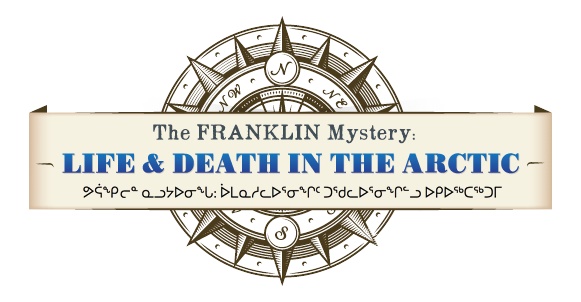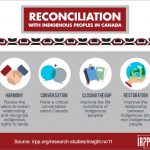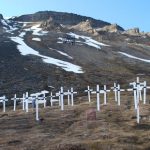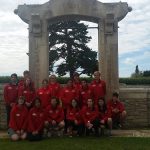
Grade 7 History, UNIT 2 – 1800-1850: CONFLICT AND CHANGE
Unit 2 Lesson 4 by Mary Kate Grey
LESSON TITLE: The Franklin Mystery: Life and Death in the Arctic
From Great Unsolved Mysteries in Canadian History, http://www.canadianmysteries.ca/sites/franklin/home/homeIntro_en.htm
TIME: 80 minutes (2 class periods)
LESSON QUESTION AND OVERVIEW:
How and why did Franklin’s expedition of 1845 flounder where Inuit had thrived for years?
Through the examination of primary and secondary source documents on
http://canadianmysteries.ca/en/index.php students will critically evaluate whether the documents are accurate and valuable to their investigation and compare evidence found in maps, journal entries and newspaper reports. Students will explore historical evidence about the tragic events and come to their own conclusions about what happened and why.
Students will work in groups of two or three and have the opportunity to choose a medium to present their findings to the class. Example: video, interview, play, essay, and journal.
Historical concepts will include cause and consequence, historical significance.
Teacher will observe students to assess level of understanding and address any misconceptions. Students will be assessed on their ability to work together as a group. Communication of learning – through student driven conversation, students should be able to communicate what they have learned and as an extension they can communicate what connections they can draw between groups of people.
EXPECTATIONS:
- Students will analyse two maps as part of their investigations into the development of and tragic events that unfolded after the Franklin Ships disappeared.
- Students will compare and contrast the special boundaries of the island as seen through both the Inuit and The British explores and discuss the perspectives of the two groups on the challenges and opportunities presented by the natural environment
- Students will assess ways in which the Inuit and the British explorers responded to the challenges that the physical environments presented
ASSESSMENT:
- For learning: Introduction: what do you know about the relationship between the Inuit and the British explorers in the 1800s? Has anyone heard about the Franklin Expedition?
- As Learning: Students will assess their own learning and work produced through a class- created list of criteria for success.
Students will be assessed during this lesson as well as prior and subsequent lessons on their ability to answer questions such as:
- How do traditional Inuit lifestyles reflect the challenges of life in Arctic regions? How do Inuit use available resources? Is their lifestyle sustainable? What types of factors might affect its sustainability?
- What are some ways in which Indigenous values regarding living in harmony with the land inform Aboriginal land use?
PLANNING NOTES:
Students will be arranged into groups of four. Provide each grouping with an envelope that includes a set of maps, two newspaper clippings and one brief description of the events of the Franklin Expedition.
A written explanation of the task will be inside the envelope to reinforce the oral explanation given at the beginning of the class. Depending on the class and availability of technology, it may be possible to send a link home with students the night before to watch the videos if they are interested. (plan for time to watch in class)
See Resource section for materials.
PRIOR KNOWLEDGE REQUIRED (of STUDENTS):
Students will have spent the entire year learning about historical thinking concepts. Students will have had exposure to thinking and application questions like:
- What makes a good historical interpretation?
- How can we decide what evidence is the most convincing?
- What makes an event historically significant?
They will have had prior lessons on critically analyzing the maps. They will have studied different landforms and environments in Canada. They will have been exposed to information about Inuit groups. They will know that Inuit means “coming from the land” as past of earlier lessons therefore, the transition to studying the environment of the land as it relates to people living on the land will be clear.
Students will have had lessons on four types of evidence – hearsay, character, circumstantial and direct.
ACCOMODATIONS/ MODIFICATIONS:
- Students will have the opportunity to choose how they would like to present their findings ( i.e., media presentation, essay, interview, etc.)
- Flip classroom option for students who may need extra time to process the material and conversely if students are eager to do further research teacher can provide links and list of books and articles.
- Teacher dictates student pairings as he/she sees best to enhance learning of students with IEPs and/or ELL students.
RESOURCES:
http://canadianmysteries.ca/en/index.php
https://www.youtube.com/watch?v=rOWzYUnXuvg – three minute clip for hook – shows the mummy
The National Film Board has a wonderful library of short documentaries and films that students can watch to better understand the natural environment that they live in such as listed below
“At the Caribou crossing Place”
Printable links and documents for envelope contents
http://www.mysteryquests.ca/quests/42/support/mq42_0004en.pdf
Maps of King William Island British and Inuit
http://www.canadianmysteries.ca/sites/franklin/archive/imageImages/original/KWIDiscoveries.jpg
http://www.canadianmysteries.ca/sites/franklin/archive/imageImages/original/OonaleeEvidence.jpg
TEACHING / LEARNING MISSIONS /DURATION (APPROX):
Minds On Part One: (3 minute video + 3-5 minute discussion)
The students will watch a 3-minute video from the National Film Board collection about Netsilik Inuit groups hunting on the ice in spring:
https://www.nfb.ca/film/group_hunting_on_spring_ice_pt_3/ (1967)
Students will also have been given the opportunity to watch the full-length documentary the night before – flipped classroom. After the video ask the students to share with their partner what are some ways in which Indigenous values regarding living in harmony with the land inform Aboriginal land use?
Students will share their ideas and a discussion about the kinds of technology, clothing, food, navigation techniques and the collaboration between the men and the men and women.
Minds On Part Two: (3 minute video + 5 minute transition into groups)
Show the students another 3-minute video revealing the frozen mummies found from Sir John Franklin’s expedition in 1845.
When the video is over have the students move into their pre-determined groups of four.
Each group will be given an “Envelope”. The envelope will contain several artefacts, including maps, diaries and pictures as well as links to websites if they want to do further research (this should be encouraged).
They will all have one main question to answer: (50 minutes)
- Why did the Franklin men perish in an environment that Inuit had been living in quite successfully for hundreds of years?
Included in the envelope will be a series of questions and charts to help organize their findings (The charts are included in the “Teacher Notes” section on mysteryquest.ca #42 Identifying and Classifying the Evidence)
- Describe similarities and differences between the two maps.
- Are the maps accurate? Why or Why not?
- What factors might have influenced the authors to write/to say what they are reported to have said? How does this observer’s evidence compare to the evidence of other observers?
- If these accounts do not agree, why would you favour one version over another?
Sharing Results (10 minute gallery walk)
Students will be asked to report their findings to the class supported by direct evidence they have found from the documents.
Each student will hand in a brief written explanation of the finding of their group in the group based on the criteria made up in previous lessons. For example: a successful write-up will include evidence to support their finding.


